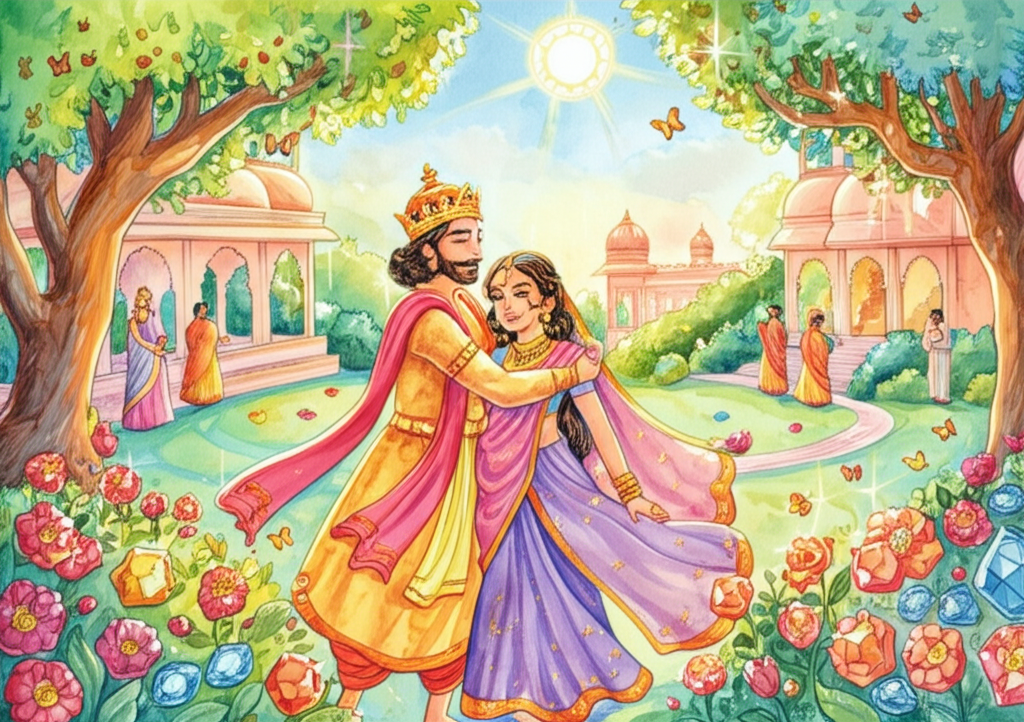Once upon a time, there was a super-rich king named Harchand Raja, and he had a son named Manikchand. He had tons of money and a big, beautiful garden with amazing flowers and yummy fruits! He loved his garden so much. Every morning, before he took a bath, he gave a poor beggar a whole bunch of gold coins.
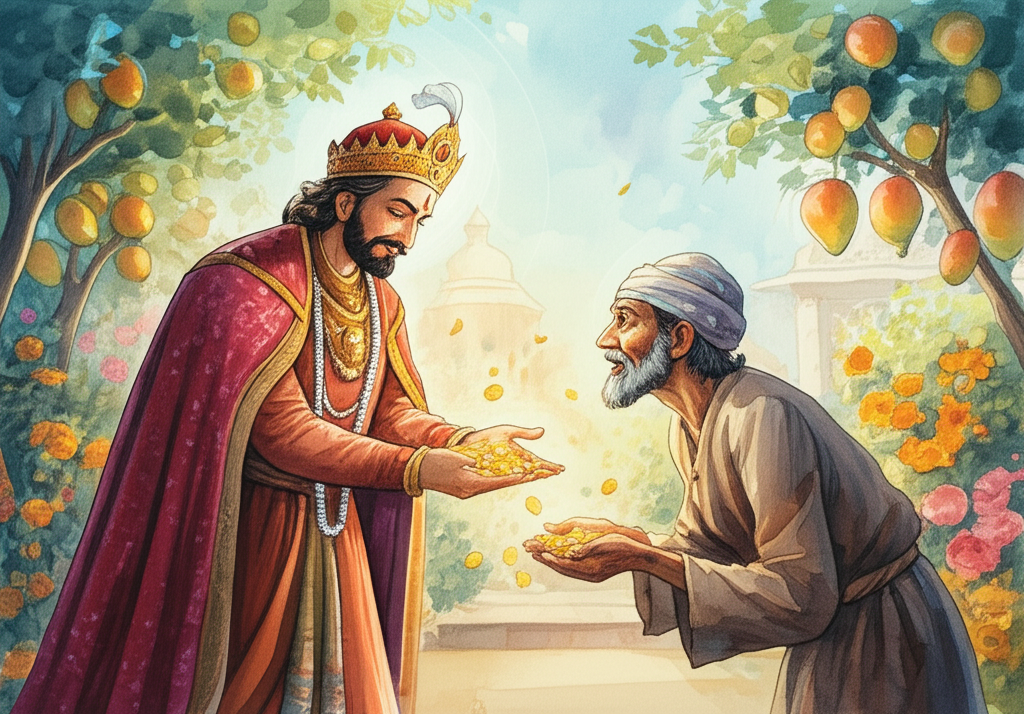
Harchand Raja prayed to God a lot, and God really liked him. One day, God said, “I want to see if Harchand Raja really loves me. I’m going to make him poor for twelve years!” That night, God turned into a giant pig and gobbled up everything in Harchand Raja’s garden!
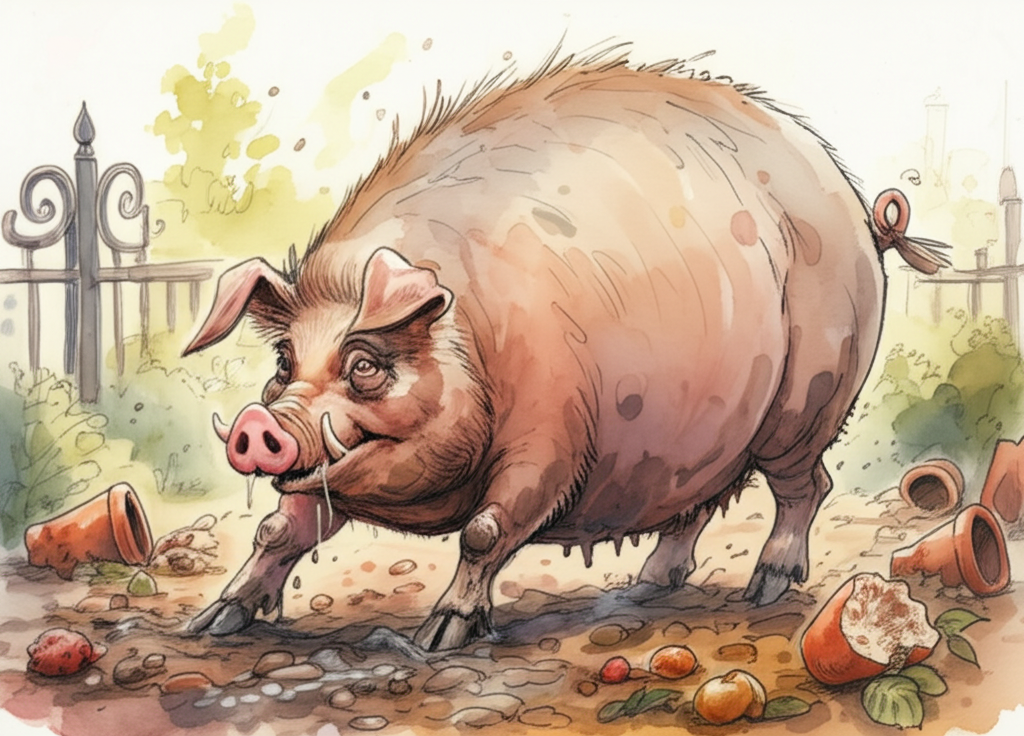
Then, the pig ran away into the forest. The next morning, the gardener woke up and looked at the garden. He couldn’t believe his eyes! It was all ruined. There was nothing left! He ran to the king and cried, “Oh, King! Your garden is totally wrecked! Last night, a pig ate everything!” The king didn’t believe him. “Nonsense!” he said. “It’s true!” said the gardener. “Come see for yourself!” So, the king got dressed and went to the garden. It was empty! He went back to the house feeling very sad. He still gave the beggar his gold coins that morning. After breakfast, he went hunting. The pig, who had run into the woods, changed into a very old beggar. He was shaking all over! As Harchand Raja walked by, the old beggar held out his hand and said, “Please give me some coins. I’m so hungry!” The king said, “Come to my palace, and I’ll give you lots of gold coins!” “Oh, no,” said the beggar. “You wouldn’t give me that much!” “Yes, I will!” said the king. “Every morning, before I bathe, I give a beggar lots of gold coins!” “Nonsense!” said the beggar. “You don’t give away your money like that!” “Really, I do!” said the king. “I promise to give you lots of gold coins!” So, the beggar followed Harchand Raja home. When they got to the palace, the king told his helper to give the old beggar his gold coins. The helper went to get the gold, but all the king’s gold, silver, and jewels had turned into charcoal! The helper ran back to the king and said, “Oh, King! All your gold and silver and jewels are charcoal!” “Oh, nonsense!” said the king. “Come see, King!” said the helper, who was really scared. The king went to see for himself and was very sad when he saw all the charcoal.
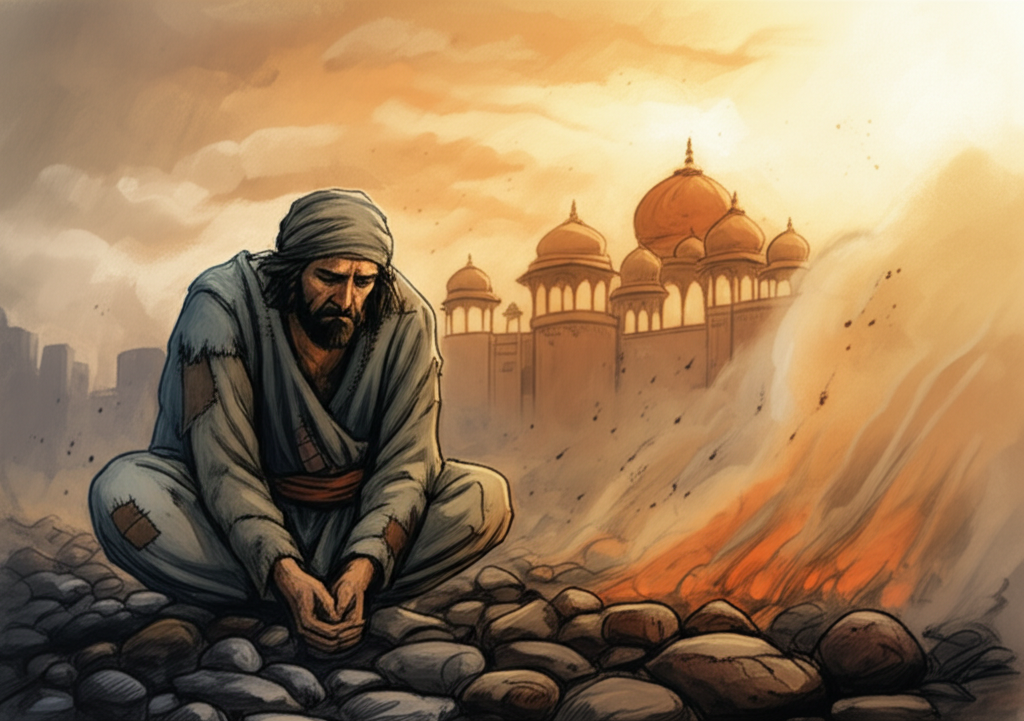
“Oh no!” he said. “God has made me very poor, but I still have to give the beggar the money I promised.” So, he went to the beggar and said, “All my gold, silver, and jewels have turned into charcoal. I will sell my wife, my son, and myself, and then I’ll give you the money I promised!” He got his wife and son, and they left the palace, their houses, servants, and everything they owned. He went to a seller and sold his queen. She was called Hirali, and she was very beautiful. The seller gave the king some gold coins for the queen. Then, Harchand Raja sold his son Manikchand to a cow herder. The cow herder gave him some gold coins for the boy. Then, he sold himself to a man who took care of a pond. He threw dead bodies into the pond. The man paid him some gold coins, and he gave the coins to the beggar, who went home. The pond man said, “Will you stay by the pond while I go home and weave baskets? If someone brings you a dead body, throw it in the water. If it’s a grown-up, take one coin. If it’s a child, take a few coins. If they don’t have any money, take a piece of cloth. Don’t forget!” Then, the pond man left Harchand by the pond. Harchand Raja stayed by the pond for many days. When people brought dead bodies, he threw them in. He took money or cloth, just like the pond man told him to. One day, Manikchand, the king’s son, died. Hirali Rani went to the cow herder to ask for her dead son. The cow herder gave him to her, and she took him to the pond. Harchand Raja was sitting by the pond, and when Hirali saw him, she said, “That’s my husband! He won’t take any money for throwing his own child into the water!” So, she went up to him and said, “Will you throw this child into the pond for me?” “Yes, I will,” said Harchand Raja. “But first, give me some coins.” “You won’t take any money for throwing your own son into the pond, will you?” said the queen. “I have to take payment,” said Harchand Raja, “because I have to do what the pond man says. If you don’t have money, give me a piece of cloth.” So, the queen tore off a big piece of her scarf and gave it to him. The king took his son and threw him into the pond.
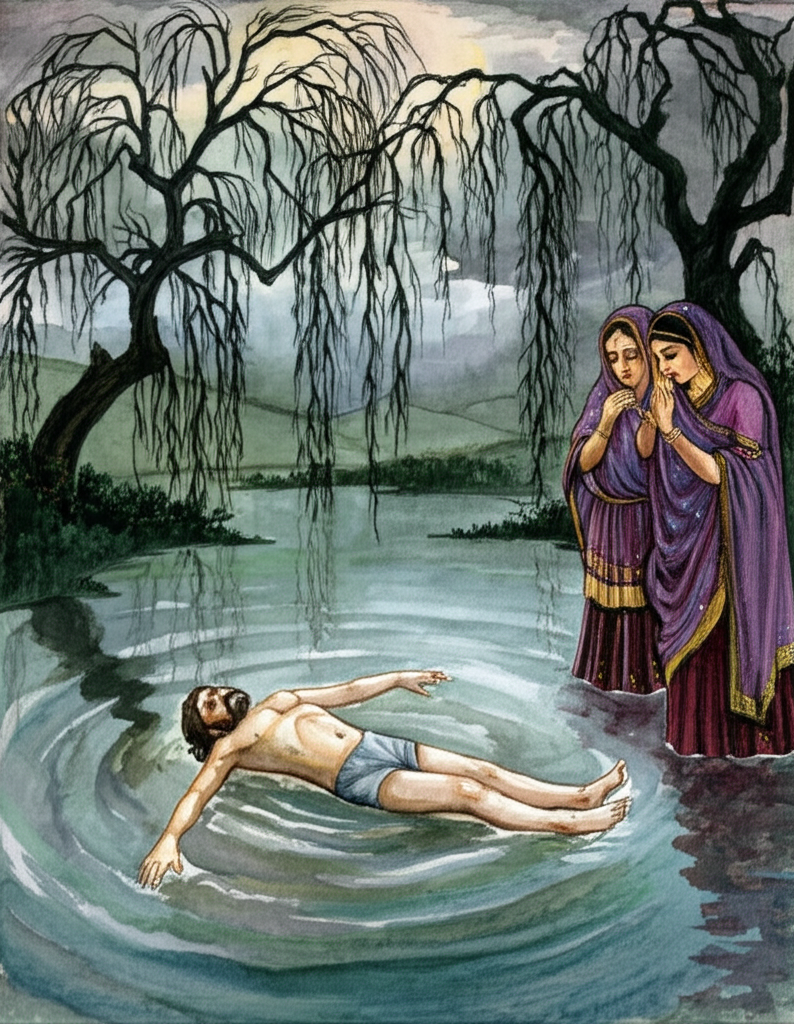
As he threw him in, he shouted to the king of the fish, who was a big alligator, “Take care of this body!” The king of the fish said, “I will!” Then, the queen went back to the seller. The king caught a fish, cooked it, and put it by the pond. He said, “I’ll go bathe and then eat it.” So, he took off his clothes and went into the pond to bathe. When he came out, he put on clean clothes. As he picked up his fish to eat it, it wiggled and jumped back into the water alive!
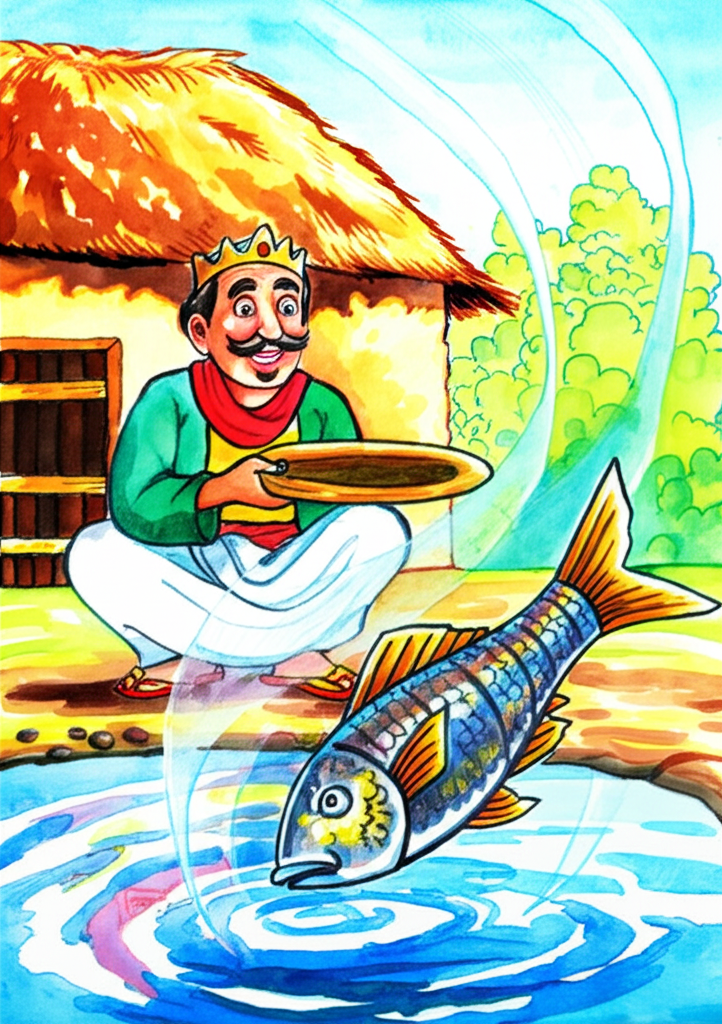
The king sat down by the pond again, feeling very sad. He said, “For twelve years, it’s been hard to find food. How long will God keep me hungry?” God was happy that Harchand was so patient and never complained. Some days later, God came down to earth as a man with an angel.
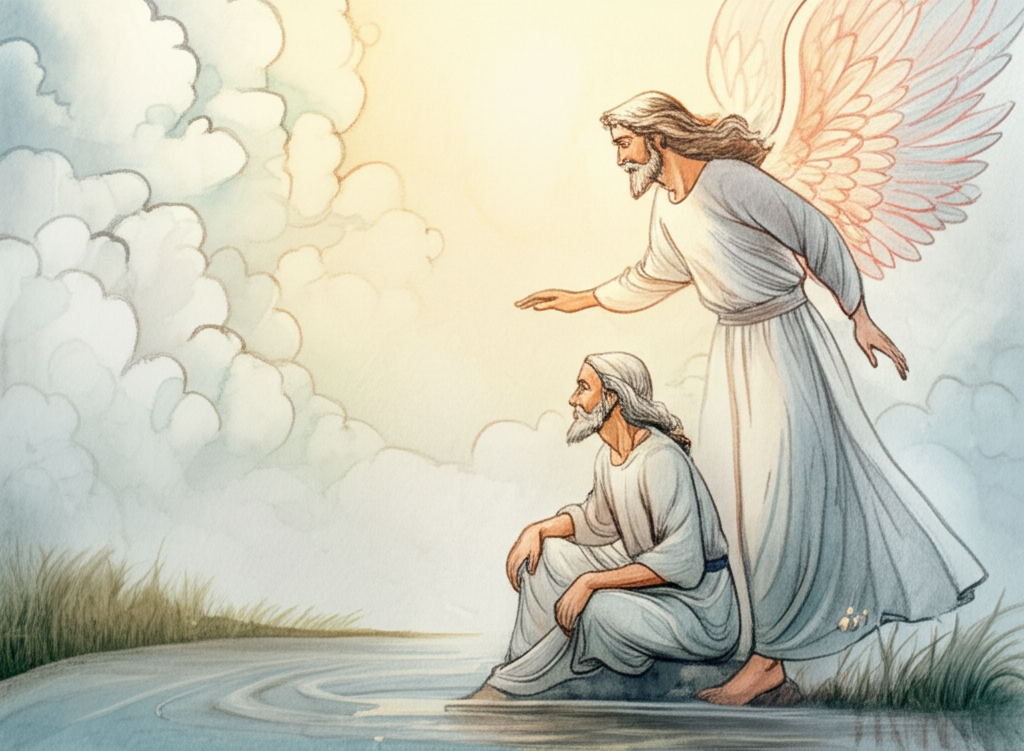
The angel said, “Let’s see who’s sitting by the pond.” “No,” said God. “I’m too tired.” “Please?” said the angel. “I really want to go!” God said, “Okay, let’s go.” So, they walked to where Harchand Raja was sitting. God said to him, “Would you like to have your wife, your son, and your kingdom back?” “Yes, I would!” said the king. “But how can I get them?” “Tell me the truth,” said God. “Do you really want your kingdom back?” “Yes, I do!” said the king. Then, Manikchand’s body, which had been floating on the water, rose up out of the water, and Manikchand was alive again! The father and son hugged each other. “Now,” said God, “let’s go to the pond man.” Harchand Raja agreed, and they asked the pond man how much he wanted for Harchand Raja. The pond man said, “I gave some gold coins for him. I want a little more.” So, they paid the pond man. Then, they went to the seller and said, “How much do you want for Hirali Rani?” The seller said, “I gave some gold coins for her. I want a little more!” So, they paid the seller, took Hirali Rani, and went to the cow herder. “How much do you want for Manikchand?” they asked. “I gave some gold coins for him,” said the cow herder. “I want a little more!” So, they paid the cow herder. Harchand Raja went home to his palace with Hirali Rani and Manikchand. He thanked the man for helping them. When they got to the palace, the garden was beautiful! The charcoal had turned back into gold, silver, and jewels. The servants were waiting for them. They went into the palace and lived happily ever after!
